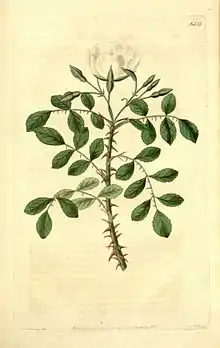Rosa abyssinica
Rosa abyssinica[1] is a rose native to sub-Saharan Africa. Non-Africans first learned of the rose in the writings of 19th-century Scottish botanist Robert Brown.[2] Rosa abyssinica is included in the genus Rosa, and the family Rosaceae.[3] No subspecies are listed in the Catalogue of Life.[3]
| Rosa abyssinica | |
|---|---|
 | |
| Scientific classification | |
| Kingdom: | Plantae |
| Clade: | Tracheophytes |
| Clade: | Angiosperms |
| Clade: | Eudicots |
| Clade: | Rosids |
| Order: | Rosales |
| Family: | Rosaceae |
| Genus: | Rosa |
| Species: | R. abyssinica |
| Binomial name | |
| Rosa abyssinica | |
| Synonyms | |
|
Rosa abyssinica var. microphylla Crép. | |
Description
Rosa abyssinica is a prickly evergreen shrub, creeping or often climbing, capable of forming a small tree up to 23 feet (7 meters) tall. It has a few prickles on the stem, slightly curved from a wide base and all similar. It has many variable features. The leaves are compound and leathery. It has 3 pairs leaflets plus one at the tip, each narrowly ovate from .5 to 2 inches (1 cm to 6 cm) tip sharp, edge toothed, on a short stalk which is winged by the leafy stipules. Flowers are of fragrant white-pale yellow, and are usually 3 to 20 in dense heads, each stalked, the sepals long, narrow and hairy, soon fall, and have 5 petals about 2 cm long, tip rounded to square, with many stamens. The fruits are green at first, but later ripen to orange-red. They are about 1 inch (2 cm) long, fleshy and edible with seed within.[4] It has been described as a "big prickly 'dog rose.’”[5]
Geographical distribution
Rosa abyssinica is found in Ethiopia, Eritrea, Yemen, Saudi Arabia,[6] Somalia and the Sudan.[7] It is common in the Ethiopian highlands and the mountains of Yemen across the Bab-el-Mandeb strait, a distribution paralleled by Primula verticillata and a few other plants.[5] It commonly forms thickets in upland dry evergreen forests, margins, clearings, upland bushland, rocky places, and riparian formations.
Uses
Food (fruit and flower), medicinal (fruit), garden, ornamental.[8]
Rosa abyssinica has sometimes been cultivated as a "living fence” surrounding home gardens in rural villages.[9]
The fruit (hips) of Rosa abyssinica is eaten, mostly by children, and is believed to alleviate fatigue or tension.[10] Birds eat the fruit as do baboons (baboons also consume the flowers). Medicinally, the fruit are eaten in as a remedy for worms (hook, tape and round). The crushed leaves have been used in remedies for hepatitis.[11]
Common and Local Names
Ethiopian rose, Wild Ethiopian rose, African rose, Abyssinian rose (English), Qaqawwii (Oromo), Dayero (Somali), Gaka (Turkish), Kega (Ethiopian - Amharic) [12]
References
- R.Br., 1814 In: Salt, Voy. Abyss. App. 64
- Brown, Robert (1866). The Miscellaneous Botanical Works of Robert Brown, Volume 1. London England: Robert Hardwicke.
- Roskov Y.; Kunze T.; Orrell T.; Abucay L.; Paglinawan L.; Culham A.; Bailly N.; Kirk P.; Bourgoin T.; Baillargeon G.; Decock W.; De Wever A. (2014). Didžiulis V. (ed.). "Species 2000 & ITIS Catalogue of Life: 2014 Annual Checklist". Species 2000: Reading, UK.
- Hedberg, I. & Edwards, S (2014). "Category 3: 'Wild Food Plants Attracting Additional Consumer Categories". Ethiopia: Famine Food Field Guide.
- Grimshaw, John (2010-05-28). "John Grimshaw's Garden Diary: Three interesting roses". John Grimshaw's Garden Diary. Retrieved 2019-08-16.
- "Flowers of Saudi Arabia | Saudi Arabian Flora". Splendid Arabia. Retrieved 2020-06-26.
- "Rosa abyssinica in Global Plants on JSTOR". plants.jstor.org. Retrieved 2019-08-16.
- "Useful Trees, Rosa abyssinica" (PDF). Old World Agroforestry.
- J.W. Watson and P.B. Eyzaguirre, editors (17–19 July 2001). "Home gardens and in situ conservation of plant genetic resources in farming systems" (PDF). Biodiversity International.
- Chekole, Getnet; Asfaw, Zemede; Kelbessa, Ensermu (2015-01-07). "Ethnobotanical study of medicinal plants in the environs of Tara-gedam and Amba remnant forests of Libo Kemkem District, northwest Ethiopia". Journal of Ethnobiology and Ethnomedicine. 11: 4. doi:10.1186/1746-4269-11-4. ISSN 1746-4269. PMC 4417315. PMID 25572933.
- Eland, F.L.S., Sue C. (1991–2013). "Plant Lives, Rosa abyssinica" (PDF). Plant Biographies.
- "category3". www.africa.upenn.edu. Retrieved 2019-08-16.
.jpg.webp)
